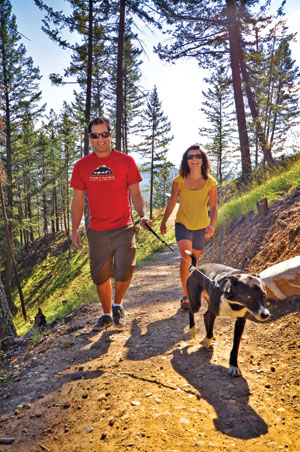
Share the valley, share the trails.
Share the trails
Jasper National Park
Share the valley
The area where the Miette, Maligne and Athabasca rivers converge is critical habitat for elk, sheep, moose and deer, and for their predators, including wolves, cougars, grizzly bears and black bears.
Recent research suggests that human use is displacing these large predators from some portions of this three-valley confluence. The areas shaded in grey are less disturbed by people and development, and so are especially important for movement of these wary species. To help us restore lost habitat, please travel only on the designated trails, avoiding unmarked trails, which are used mainly by wildlife. A few designated trails are also shown in grey, because they, too, are heavily used by wildlife. To protect the animals, restore habitat and avoid conflicts, we suggest that you avoid these trails.
All trail users please note
- Share the trail. Treat other users with courtesy and respect.
- Stay on the trail. Short-cutting and going around mudholes or snow damages trailside vegetation.
- Choose a trail that matches your ability. Reading this guide will help, as will asking park staff or outdoor-shop employees.
- Some trails are restricted to pedestrians only.
- Creating new trails without authorization is not allowed.
- Be prepared! Jasper National Park is a wilderness area. Caution and self-reliance are essential
National-park basics
 Keep dogs on a leash.
Keep dogs on a leash. © Parks Canada
- Motorized vehicles on public roads only.
- Pack out litter.
- Leash your pet.
- Keep food away from wildlife.
- No picking or collecting.
Wildlife
You will almost certainly see wildlife on your outing. Birds, squirrels, deer, elk, moose, mountain goats, bighorn sheep, bears, coyotes...the list of possibilities is long.
Are the larger animals dangerous? Any animal can be aggressive if it feels threatened. Stay at least 50 m away from female elk in the spring calving season and male elk in the fall rutting season, and at least 100m away from bears. *Read the Parks Canada's Bears and People
Never approach or feed a park animal. It could hurt you, and, in one way or another, feeding will usually kill it. Feeding wildlife is unlawful.
Animals are used to seeing people on the trails described in this brochure. If an animal knows where to expect you, there's a better chance that it will not react aggressively when you encounter it.
But if you're not on the trail, if you're short-cutting through the woods, say then you may startle an animal such as a bear. This is a dangerous situation. For your safety, and to give the park wildlife enough room to carry on their lives, stay on the trails.
Drinking water
Carry at least a litre of safe drinking water on any hike, two litres or more if you are going to be out all day. Tap water from Jasper is safe.
Surface water is often contaminated with Giardia, an intestinal parasite that can cause serious health problems. Heating water to the boiling point will kill the organism. Or use a pump-filter certified to block Giardia cysts.
Fishing
If you plan to fish in the park, you need a Parks Canada permit, available for a fee at information outlets, warden offices and tackle shops in Jasper. A copy of the fishing regulations summary is provided with each permit.
Horses
Yes, you can take your horse for day-rides in Jasper National Park. Private horse travel is permitted throughout the park, except in picnic sites, campgrounds or camping facilities accessible by motor vehicle or for hikers only, in public-use areas within the town of Jasper, and on certain trails.
For more information about riding, please ask for the Horse-user's Guide at the Park Information Centre.
Mountain-bikers
- Please avoid skidding. Locking your brakes causes severe erosion.
- When approaching other trail users, slow down. When passing from behind, sound your bike bell or call out well in advance, and ask to pass.
- Pedestrians and horses have the right of way. When horses approach, you should stop, move your bike off the lower side of the trail and wait there until they pass by.
Safety
The park is managed as a natural area, and hazards that are part of the wilderness are also part of the park. You are ultimately responsible for your own safety, so please be careful.
Approach new places and new activities cautiously. Hike with companions. Tell someone where you are going and when you plan to return. Bring enough food and water. Pack extra clothing in case the weather changes. Carry this guide with you. For more information about public safety, consult park staff.
Transportation
Jasper National Park is a big place, and there isn't much public transportation. Fortunately for hikers who don't have a car or a bicycle, the Pyramid Bench area has many fine hikes from trailheads right at the edge of town. For the more distant trailheads, you may be able to arrange for drop-off and pick-up by one of the local transport companies.
If you see a damaged sign, please report it at the Park Information Centre in Jasper.
- Date modified :